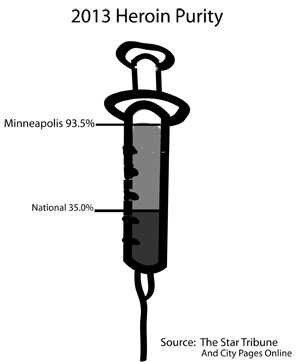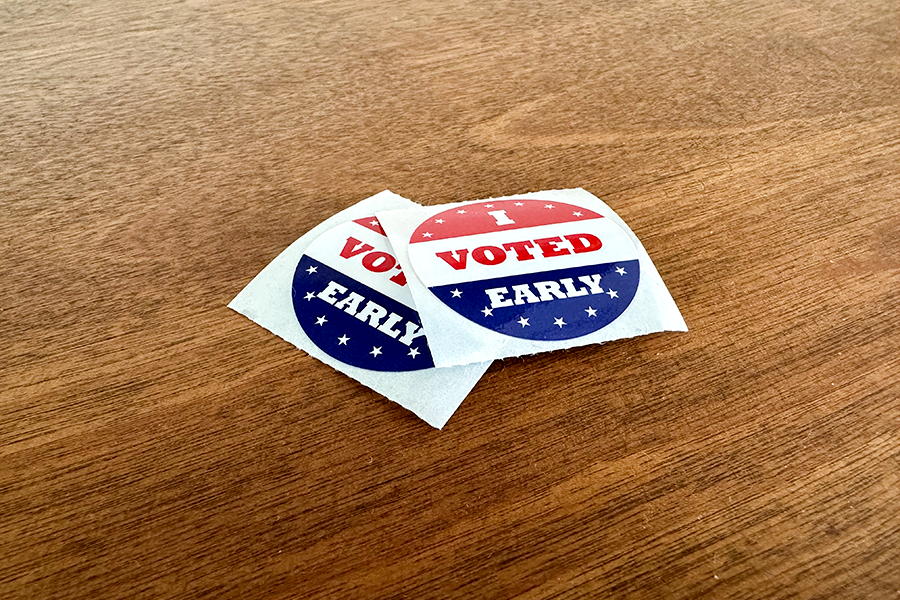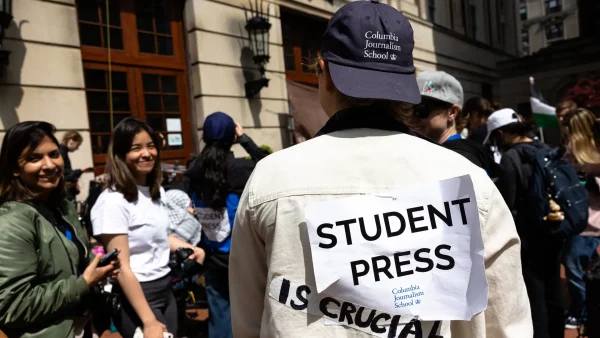Heroin addiction on the rise in the Twin Cities

March 11, 2014
“I would never have ever used heroin in a million years if I wasn’t depressed,” explained John, a recent South graduate and a recovering heroin addict, who wished to remain anonymous. “If you are an addict like I am it is very easy to become addicted to a drug.”
John’s situation is not unique. Heroin addiction has been on the rise in the past decade. The Drug Enforcement Administration classifies heroin as a schedule one drug because it has potential for abuse and currently has no medical use.
Seven seconds after the user injects, heroin reaches the brain of the user and this euphoric rush starts. It lasts for about 15-20 minutes and is followed by state of semi-conscious sleepiness which can last for about three hours according to John. “It is a euphoric, light headed [feeling]. It feels amazing. No one thing really feels better, which is something that is really hard to come to terms with when you’re trying to recover,” described John.
According to the Substance Abuse and Mental Health Services Administration (SAMHSA), a branch of the US Department of Mental Health and Human Services, from 2002 to 2012 the number of people older than 12 who have used within the last year have increased from 404,000 to 669,000 users in the nation. Additionally, in 2010, drug overdose caused more deaths than motor vehicle traffic crashes for people aged between 25 and 64.
“There are always people who idolize drug users. Everyone thinks its so tragically beautiful when people overdose. Everyone loves Kurt Cobain,” explained John, “I think its important for everyone to realize that its not more than someone using a dirty drug and dying. Hurting everyone they love. There is no artistic, complex beauty involved.”
Heroin has been brought to the media’s and the world’s attention by the overdoses of celebrities like Cory Monteith and Philip Seymour Hoffman. However, this drug is not as distant as you may think. According to data collected by Kare 11 in 2013, 54 people died in Hennepin County, which is more than the combined cases of methamphetamine and cocaine.
“[Heroin is] one of the things you can die from really easy, because you don’t know what dose you’re getting when you’re taking heroin,” explained Leslie Stunkard, the Licensed Alcohol and Drug Counselor for the Minneapolis Public School district, “Usually dealers cut it with something to make more money. As it happens Minneapolis is on a pipeline. The concentration in Minneapolis is very high compared to other cities. So usually when people overdose it’s accidental, they’re not trying to commit suicide.”
“In Minnesota, we’ve seen an alarming spike in heroin use over the past year, especially among young people,” Senator Amy Klobuchar said in an email. “We need to reverse this trend and step up our efforts to prevent drug addiction, raise awareness, and keep our families and communities safe from this destructive drug.”
The Twin Cities metro area has the highest purity of heroin in the United States at 93.5%, according to the Star Tribune. Many dealers view the metro area as an untapped market and therefore plug the market with purer heroin to increase addiction. This directly causes more overdoses, reported Fox Twin Cities News. Additionally, 5 Eyewitness News explained that mainly 18-25 year olds get hooked, and 80% of them started by abusing prescription pills.
“I was doing Oxycodone junior year, so I knew I liked that kind of thing. Senior year there was somebody that I worked with that had unlimited supply of promethazine sodium cough syrup. . . almost everyone thinks pills are cool. It almost doesn’t even matter what the pill is, kids are like ‘oh cool I’ve got pills,’” explained John. “Kids need to realize that it’s not as cool as they think it is. A lot of parents don’t realize that a lot of the time their medications are stuff that their kids could get high [on].”
Although John did not start using heroin in high school, Stunkard confirmed that heroin is used by some Minneapolis Public High school students. She described, “the profile of the new heroin user is suburban, middle class, [or] upper middle class, caucasian.”
Stunkard explained, “I think that the heroin epidemic that we’re facing, starts with abuse of painkillers and I think that having them available and accessible in their home and other people’s homes, almost all kids (that I’ve talked to) who’ve tried heroin, start with Vicodin or Oxycodone or some of the other opiates.”
Similarly, John explained that pills led him to transition to heroin after high school. “By the time I was in college I was really depressed, and I was just like [heroin is] the next step I guess. I knew it was similar, I knew it was better, and I knew it was cheaper. I just started using dope.”
CBN’s anchor Linda Mintle explained on TV that the switch to “pain killer’s cousin” is not “about willpower.” She explains, “You cannot will yourself off the biological pull that is in the brain.” According to Narcotics Anonymous, “an addict is a man or woman whose life is controlled by drugs. We are people in the grip of a continuing and progressive illness whose ends are always the same: jails, institutions, and death.”
For John, his addiction came on slowly. “In high school when I was using Oxycodone, opiate pills, and drinking, I would use on the weekends at parties. It stayed that way, even my first times using heroin it was still a weekend thing, in 2011. Then I could kinda tell that I was addicted but it wasn’t full blown.”
“I kind of weaned myself off of it and started to drink a lot to cope with the withdrawal there,” John continued. “I ended up in treatment. I spent 6 months sober. I had a couple of relapses, but then last spring (of 2013), I hit it hard. I was shooting up everyday. It was crazy. Eventually I was spending $60-80 every day just for drugs. This summer I spent $10,000 on drugs.”
Not only did it affect John financially, it affected his personal life as well. “[John] would come over sometimes. He would be high on heroin and he would be mean to my sister,” recalled sophomore Ben (not his real name), John’s little brother. “I remember one time he said something mean to my sister and my parents yelled at him for it. He said it wasn’t fair, ‘you can’t yell at me.’ We got kind of mad. Then we knew something was up.”
““You can’t make people [get help], especially adults,” said South High Chemical Health counselor Anne Gorton. She explained further, “I can think of two students last year that shared that among other things that they have tried heroin . . . One wanted help, one didn’t. Both were 18. Ultimately, I don’t know the end of their story. The one student that wanted help went and got an assesment and got referred to a program. I don’t know if that student completed it. The other student just kind of dropped off the school radar.”
Although there may have only been two students who talked to Gorton about heroin last year, Stunkard believes that, “the numbers in the city have gone up hugely.”
Although heroin may be increasing in popularity, John recalls that heroin was not a fun drug. He said, “Basically you don’t do it for fun, you do it because you are trying to get rid of some stress or you are trying to forget about how much you hate yourself.”
“As soon as I was addicted, getting sick [from withdrawal], and lying about it, I kind of wished I would stop, to an extent. It took 100% wanting to stop [to quit],” John described. “The whole time [I was using] I wanted to stop, but if I had really wanted to stop I would’ve checked myself into treatment. It took a catalyst, like overdosing, to really realize I needed to stop. It took everything I could to actually be able to seek help.”
In September 2013, John said his girlfriend found him “blue-faced and passed out.” She called 911 and according to John, the medics had to revive him in the hallway of his apartment building.
“I got home from school one day. I was putting my bike in the porch and my sister came out and was like, ‘John OD’d. He’s in the hospital.’ I didn’t know what to say and I was really scared,” recalled Ben.
Senior Ella (not her real name), John and Ben’s sister, explained,“I got pretty scared because I was worried for his life. He’s always been there. There’s always good and bad points in life. It’s like I kinda didn’t want to think about it. It stresses me out. I want him to live. I don’t want to have to think about the reason why he’s struggling.”
“It worried me. It’s kind of separated us,” she added.
After 8 months of lying to his family and girlfriend, John’s overdose forced him to reveal the truth to his loved ones. Lying isn’t uncommon for heroin addicts. He recalls a counselor telling his mom that, “you actually can’t trust an heroin addict until they’ve been sober for over a year.”
Bradford Stone, spokesperson for Substance Abuse and Mental Health Services Administration (SAMHSA) said in a phone interview that when people come to them for help they try to, “point out to people that if they’re in pain either emotionally or physically, there are things to do other than self-medicate through illicit drugs. For those that are already addicted to heroin or other illicit drugs we try to sponsor treatment programs and get the word out that recovery works. You can return to a rich, fulfilling life. There are many resources there that you can use to get you back to recovery.”
After his overdose, John has been trying to keep a sober life. He went to an outpatient rehabilitation center, and has been sober for several months. He has been working to get rid of triggers such as biking down Franklin Avenue or seeing his drug dealer’s car, by making new sober memories.
“Although he may still be working on some things, I think he is doing great. He’s got a couple of jobs and he’s back at school. He’s living on his own,” added Ella. “I think he’s been able to mature a lot after this. It’s too bad that it happened but it may have helped him understand his family better.”
John explained, “Now I do meetings and its tough. Basically I had to use every resource available. Thats what you have to do. You have to really commit, you have to want it. You have to want to commit. Anytime you hear about a resource, read about a resource you have to use that resource. You can absolutely not do it alone.”
Part of the reason why heroin is so hard to come off of is the detox. Stunkard explained, “If you are a regular heroin user the detox from heroin is ugly. Marijuana is very addicting but the detox you can live through. You can live through a heroin detox but some people don’t. You can have seizures. I’m not talking about someone who has used once, I’m talking about somebody whose body is used to having it. So if they’re going to do [detox from heroin], have medical supervision.”
For users looking to become clean, John recommends, “inpatient treatment for a couple weeks, after detox. Then out patient [treatment], then meetings. For me I couldn’t do inpatient this time around because I’m in school. It’s the only thing that I have to kind of motivate me to keep moving forward.”
As this drug increases popularity, John wants someone who is considering using heroin to know that, “you may think it seems cool now, but I can tell you for a fact in some amount of years you’re going to look back and feel that you wasted life. It’s just not worth it, I guess.”





